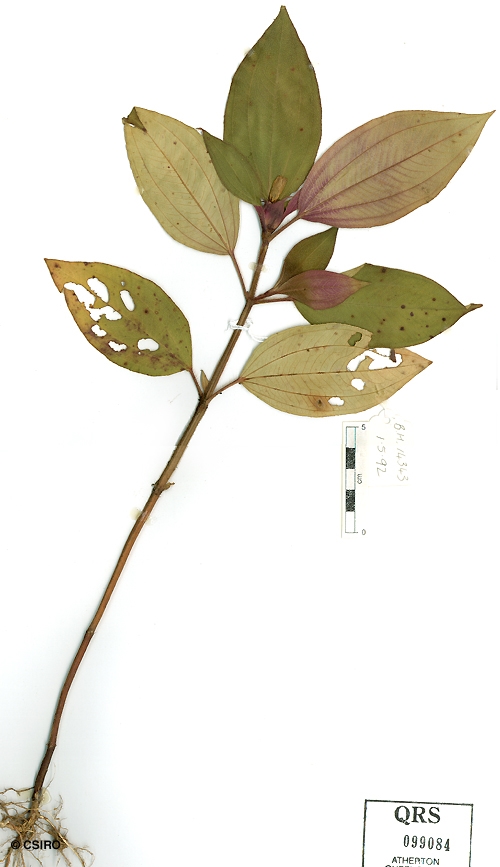Australian Tropical Rainforest Plants - Online edition
Tristemma mauritianum J.F.Gmel.





Gmelin, J.F. (1791) Systema Naturae : 693. Type: Mauritius, Commerson s.n.; holo: P. Fide H. Jacques-Felix, Bull. Mus. Hist. Nat. (Paris) ser.3, no. 418, Bot. 28: 137 - 207 (1976).
Tristemma
Usually flowers and fruits as a shrub about 1 m tall.
Leaf blades 3-nerved, about 5-15 x 3-7 cm. Both the upper and lower surfaces of the leaf blade clothed in simple, +/- prostrate hairs. Each leaf with a midrib and two major longitudinal veins plus two other longitudinal veins which could nearly be regarded as intramarginal veins. Petiole bases joined by a definite line running across the twigs.
Hypanthium with two or three rings of hairs towards the apex. Calyx lobes about 3-6 mm long. Petals about 6-10 mm long. Stamens ten, +/- uniform, each with a pair of glands on the filament slightly below the anther, filaments normally bent where the glands are attached. Anthers with a terminal pore.
Fruit about 10 x 6 mm, calyx persistent at the apex. Fruit fleshy, splitting irregularly. Seeds immersed in a whitish pulp. Seeds small, about 0.6 mm long, cochleate, testa tuberculate.
Cotyledons small, about 1.5-2 x 1.5-2 mm. Hypocotyl terete but the stem above the cotyledons 4-angled with erect hairs on each angle. First pair of true leaves triplinerved with a few white hairs scattered on the surface. At the tenth leaf stage: leaf blade with a midrib and two major longitudinal veins plus two other longitudinal veins which could nearly be regarded as intramarginal veins. Upper and lower surfaces clothed in pale prostrate hairs. Stem hairy, shortly 4-winged. Seed germination time 10 to 25 days.
An introduced species, originally from western and central Africa and Madagascar, now naturalised in NEQ particularly in the Innisfail-Babinda area. Altitudinal range from near sea level to 550 m. Grows along roads and in disturbed areas in well developed lowland and upland rain forest.
This species was probably introduced because of its showy pink flowers. The introduction was probably effected by a family from Mauritius who settled in the Frenchman Creek area in 1883.





